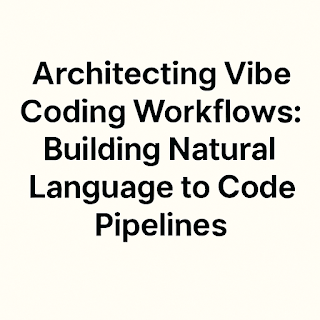Architecting Vibe Coding Workflows: Building Natural Language to Code Pipelines
Blueprint for designing systems that capture intent, process prompts, and generate high-quality code
🟢 Introduction (150–200 words)
Software development is undergoing a transformation with the rise of Vibe Coding—an approach that lets developers express what they want in natural language while AI handles implementation details. Yet, moving from idea to working code isn’t just about pasting a prompt into a chatbot; it requires robust pipelines that reliably capture intent, process it, and produce high-quality outputs developers can trust. Without thoughtful architecture, organizations risk unreliable code, security vulnerabilities, and productivity bottlenecks.
In this guide, I’ll walk you through a practical blueprint to architect Natural Language to Code (NL2Code) workflows that balance creativity with control. Drawing on my experience building LLM-powered developer tools for enterprises, I’ll share the key capabilities you need, common pitfalls to avoid, and actionable steps to integrate Vibe Coding into your existing stack—so you can unlock faster, safer, and more human-centric software delivery.
🧑💻 Author Context / POV
As a technical architect working on developer productivity platforms, I’ve seen firsthand how quickly unstructured prompts can lead to inconsistent outputs. Building pipelines that turn vibes into valuable, maintainable code has become a cornerstone of my work.
🔍 What Is Vibe Coding and Why It Matters
Vibe Coding refers to the practice of using natural language to convey coding intent. Developers describe what they want instead of how to do it, and AI systems generate the implementation. This matters because:
-
It lowers the barrier to entry for beginners.
-
Speeds up prototyping by reducing boilerplate work.
-
Shifts focus from syntax to system design.
-
Aligns closely with how humans think and communicate.
But it’s only valuable if your workflow produces reliable, secure, and maintainable code.
⚙️ Key Capabilities for a Reliable Vibe Coding Pipeline
-
Intent Capture Layer
-
Structured prompt interfaces (e.g., specialized editors or UI forms) to avoid ambiguity.
-
Context enrichment (project metadata, existing codebase state).
-
-
Prompt Processing Engine
-
Syntax-aware LLMs fine-tuned on your tech stack.
-
Guardrails: prompt templates with variables for consistent outputs.
-
-
Code Generation Module
-
Streaming APIs or batch jobs to generate code at scale.
-
Post-processing for linting, static analysis, and auto-formatting.
-
-
Validation & Feedback Loop
-
Integration tests or sandbox execution to catch runtime errors early.
-
User review step before merging into the main branch.
-
-
Audit & Logging
-
Store prompts, generated code, and decision logs for debugging and compliance.
-
🧱 Architecture Diagram / Blueprint
ALT Text: Natural Language to Code pipeline architecture showing intent capture, prompt processing, code generation, validation, and human approval stages.
🔐 Governance, Cost & Compliance
🔐 Security:
-
Isolate LLM requests with dedicated VPC endpoints.
-
Use code signing to prevent tampering of generated files.
💰 Cost Controls:
-
Implement concurrency limits on LLM API calls.
-
Monitor average tokens per prompt to control spend.
📜 Compliance:
-
Log prompt-code pairs to support audits.
-
Enforce code style policies and dependency license checks.
📊 Real-World Use Cases
🔹 Component Generators:
A React component library team reduced dev time by 40% using vibe-based pipelines for repetitive UI elements.
🔹 Infrastructure-as-Code Automation:
A DevOps team replaced manual Terraform scripting with natural language prompts that generated validated IaC modules.
🔹 Internal API Wrappers:
A fintech startup used Vibe Coding to quickly create consistent, documented API clients in multiple languages.
🔗 Integration with Other Tools/Stack
-
IDEs: Plugins for VS Code or JetBrains to surface Vibe Coding in the developer’s daily workflow.
-
CI/CD: Run generated code through automated security scans and testing.
-
ChatOps: Allow prompt submission and code previews directly from Slack or Teams.
✅ Getting Started Checklist
-
Define a clear prompt template for each code type (components, APIs, scripts).
-
Set up isolated environments for generated code testing.
-
Establish LLM usage limits and monitoring.
-
Pilot with a small, low-risk module before wider rollout.
🎯 Closing Thoughts / Call to Action
Vibe Coding isn’t just a gimmick; when architected well, it becomes a force multiplier for development teams, enabling faster delivery, reducing human error, and sparking creativity. By following this blueprint for Natural Language to Code pipelines, you’ll be equipped to turn fuzzy ideas into robust software—all while keeping security, governance, and developer control at the forefront.
Ready to bring Vibe Coding to your workflow? Start with one pilot, set guardrails, and iterate—because the future of coding is more human than ever.
🔗 Other Posts You May Like





Comments
Post a Comment